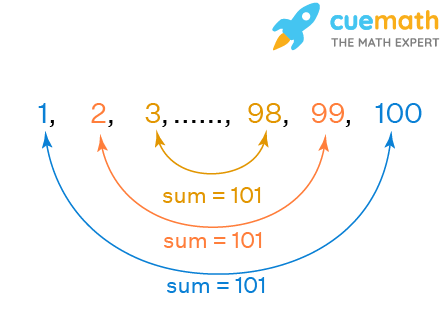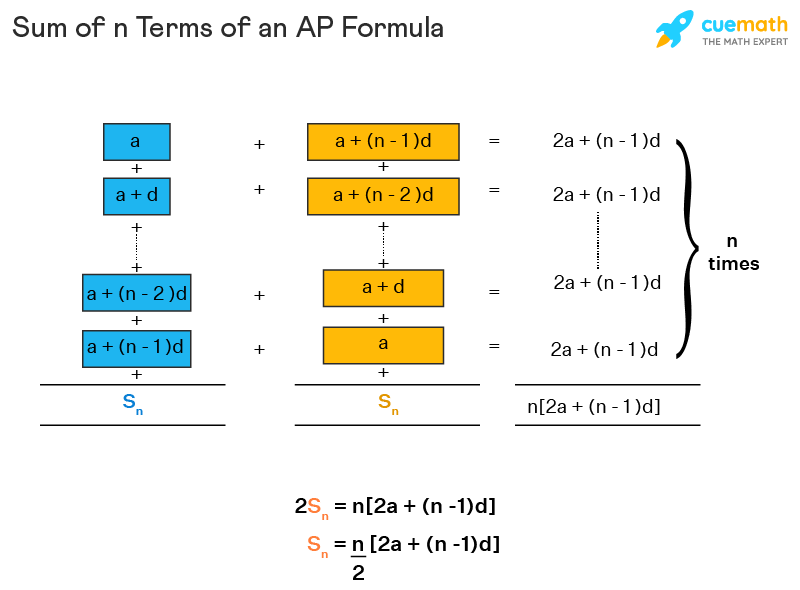Sum of n Terms of an AP
An arithmetic progression is a sequence of numbers or variables in which the difference between consecutive terms is the same. There can be an infinite number of terms in an AP. To find the sum of n terms of an AP, we use a formula first founded by Johann Carl Friedrich Gauss in the 19th century. Let us learn all about the sum of n terms of an AP in this article.
| 1. | What is Sum of n Terms of an AP? |
| 2. | Sum of n Terms of AP Formula |
| 3. | Sum of n Terms of AP Proof |
| 4. | Sum of AP Formula for an Infinite AP |
| 5. | FAQs on Sum of n Terms of an AP |
What is Sum of n Terms of an AP?
In the 19th century in Germany, a Math class for grade 10 was going on. The teacher asked her students to sum all the numbers from 1 up to 100. The students were struggling to calculate the sum of all these numbers. One boy shouted out the answer 5050 while the other students were still in the initial steps of calculating the sum. This boy was the great German mathematician Carl Friedrich Gauss. How did he arrive at the sum so quickly?
Well, he noticed that terms equidistant from the beginning and the end of the series had a constant sum equal to 101.

We can see that in sequence 1, 2, 3, ..., 100, there are 50 such pairs whose sum is 101. Thus, the sum of all terms of this sequence is 50 × 101 = 5050.
Sum of n Terms of AP Formula
The sum of n terms of an AP can be easily found out using a simple formula which says that, if we have an AP whose first term is a and the common difference is d, then the formula of the sum of n terms of the AP is Sn = n/2 [2a + (n-1)d].
In other words, the formula for finding the sum of first n terms of an AP given in the form of "a, a+d, a+2d, a+3d, ....., a+(n-1)d" is:
Sum = n/2 × [2a + (n-1)d]
Now, let us discuss one more case for the sum of n terms of an AP formula, which is "What will be the formula of the sum of n terms in AP when the last term of the progression is given?".
Sum of n Terms in AP when Last Term is Given
The sum of the first n terms of an arithmetic progression when the nth term, an is known is:
Sn=n/2 × [a1+an]
Sum of n Terms of AP Proof
In this section, we are going to learn the proof of sum of n terms of an AP formula. Let us consider the arithmetic progression with n terms:
a, a+d, a+2d,... (a+(n−2)d), (a+(n−1)d)
The sum of n terms of this progression is:
Sn =a + (a+d) + … + (a+(n−2)d) + (a+(n−1)d) → (1)
By reversing the order of the terms of this equation:
Sn = (a+(n−1)d) + (a+(n−2)d) + … + (a+d) + a → (2)
We see that the sum of corresponding terms of equation (1) and equation (2) yield the same sum which is 2a+(n−1)d. We know that there are totally n terms in the above AP. So by adding (1) and (2), we get:

2Sn = n(2a+(n−1)d)
Sn = n/2 (2a+(n−1)d)
The above sum of arithmetic progression equation can be written as:
Sn = n/2 (2a+(n−1)d)
Sn = n/2 (a+a+(n−1)d)
Sn = n/2 (a1+an) [∵ an = a+(n−1)d and a = a1]
Thus, the sum of arithmetic progression equations are:
Sn = n/2 (2a+(n−1)d), or,
Sn = n/2 (a1 + an)
Let's take a look at the following flowchart to get an idea of the formula that has to be used to find the sum of arithmetic progression according to the information available to us.

Sum of AP Formula for an Infinite AP
Let us consider an example for the sum of an infinite AP.
2 + 5 + 8 + ...
Here, the first term is a = 2. The common difference is d = 3. The number of terms is, n = ∞. Substitute all these values in sum of AP formula:
Sn = n/2 (2a+(n−1)d)
Sn = ∞/2 (2(2)+(∞−1)3)
Sn = ∞
We found the sum of infinite AP to be ∞ when d > 0. In the same way, the sum of infinite AP is −∞ when d < 0.
Thus, \(\text { Sum of infinite } A P=\left\{\begin{array}{ll}
\infty, & \text { if } \quad d>0 \\[0.3cm]
-\infty, & \text { if } \quad d<0
\end{array}\right.
\)
Sum of n Terms of AP Tips and Tricks:
- The sum of arithmetic progression whose first term is a and the common difference is d can be calculated using one of the following formulas: Sn = n/2 (2a+(n−1)d) and Sn = n/2 (a1+an).
- The sum of AP of n natural numbers is n(n+1)/2.
Challenging Questions:
- Find the sum: 115, 112, 110,…, to 13 terms.
- How many terms of the AP 9, 17, 25, ... must be taken to give a sum of 636?
☛ Related Topics:
Sum of n Terms in AP Examples
-
Example 1: Calculate the sum of the first 20 terms of the following AP: S = 190 + 167 + 144 + 121 + …
Solution:
Using the sum of n terms of an AP formula,
S = n/2 (2a+(n−1)d).
Here, we have a = 190, d = −23, and n = 20. Substituting all these values in the above formula,
S = 20/2 (2(190)+(20−1)(−23))
=10 (380−437)
= 10(−57)
= −570
Answer: Therefore, the sum of the first 20 terms of the given AP is - 570.
-
Example 2: Consider the following AP: 24, 21, 18, … How many terms of this AP must be considered so that their sum is 78?
Solution:
Let the number of terms that give the sum 78 be denoted as n. We have a = 24, d = −3, and S = 78. Substituting all these values in the sum of n terms of an AP formula,
S = n/2 (2a+(n−1)d)
⇒ 78 = n/2 (48−3(n−1))
⇒ 78 = n/2 (51−3n)
⇒ 3n2 − 51n + 156 = 0
⇒ n2 −17n + 52 = 0
⇒ (n−4)(n−13) = 0
⇒ n = 4, 13
Answer: Therefore, the sum of either 4 terms or 13 terms of the given AP is 78.
-
Example 3: Given a = 5, d = 3, and an = 50, find the value of Sn.
Solution:
The given values are a = 5 = a1, d=3, and an=50. We know that the nth term of AP is given by the formula an = a+(n−1)d.
⇒ 50 = 5+(n−1)3
50 = 5+3n−3
50 = 3n+2
48 = 3n
16 = n
By using the sum of AP formula,
Sn = n/2 (a1+an)
Sn = 16/2 (5+50)
Sn = 8(55)
Sn = 440
Answer: Therefore, the value of Sn is 440.

FAQs on Sum of n Terms of an AP
What is the Sum of n Terms of an AP Formula?
The sum of n terms of an AP can be found using one of the following formulas:
- Sn = n/2 (2a+(n−1)d)
- Sn = n/2 (a1+an)
Here, a = a1 = the first term, d = the common difference, n = number of terms, an = nth term, Sn = the sum of the first n terms.
What is the Commonly Used Sum of AP Formula?
The formula to find the sum of n terms in AP is Sn = n/2 (2a+(n−1)d), in which a = first term, n = number of terms, and d = common difference between consecutive terms.
What is the Sum of First n Terms of an AP: a, 3a, 5a ...?
The given AP is a, 3a, 5a, ... The first term is a and the common difference is 2a. The sum of n terms of the given AP is Sn = n/2 (2a+(n−1)2a).
⇒ Sn = n/2 (2a + 2an - 2a)
⇒ Sn = n/2 (2an)
⇒ Sn = an2
The sum of n terms of AP a, 3a, 5a, ... is an2.
What is the Sum of an Arithmetic Sequence?
The sum of an arithmetic sequence is the sum of all the terms in it. We use the first term (a), the common difference (d), and the total number of terms (n) in the AP to find its sum. The formula used to find the sum of n terms of an arithmetic sequence is n/2 (2a+(n−1)d).
What is the Sum of n Terms of an AP when the Last Term is Given?
If an is the nth term of an arithmetic progression, a is the first term, and n is the total number of terms, then we can use the following formula to find its sum: Sn = n/2 (a1+an).
visual curriculum